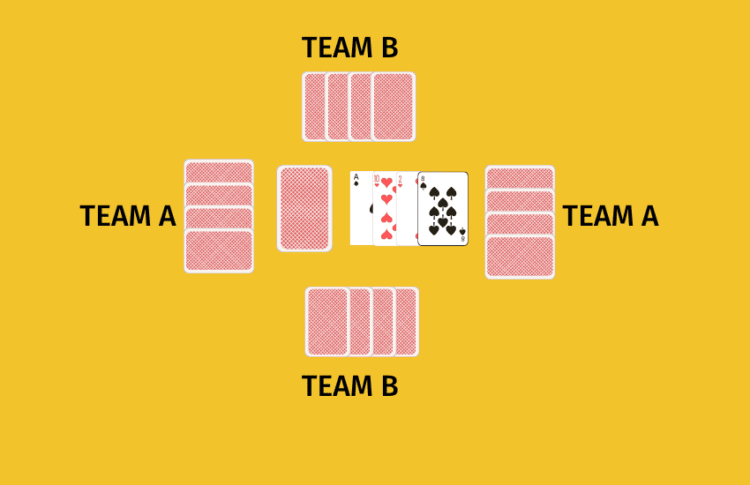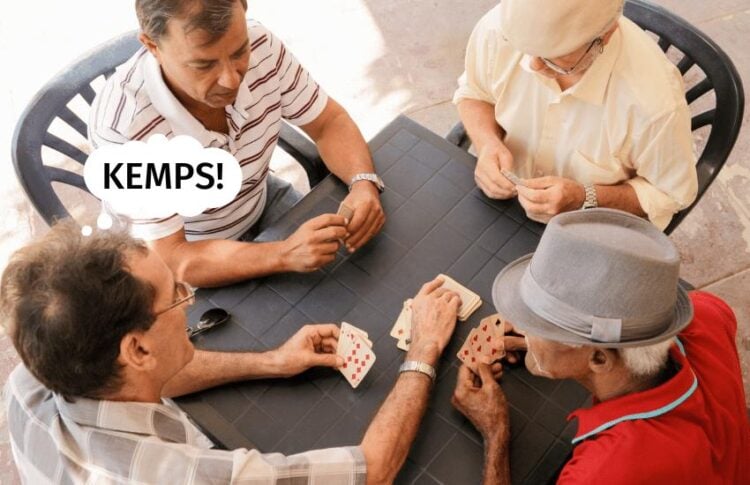
OBJECTIVE OF KEMPS: Acquire a four of a kind and cue to your teammate to declare Kemps.
NUMBER OF PLAYERS: 2-6 players (even number of players)
MATERIALS OF KEMPS: 52-card deck
TYPE OF GAME: Card game
AUDIENCE: Adult
OVERVIEW OF KEMPS
Kemps is one of those ice breaking games that you can bust out at any gathering, and it will be an instant hit! Playing with alcohol makes the game even more fun, but it is not necessary to play. It is also known as Kent, Cash, Canes, or even Gemsh, depending on where you’re from. The best part about this game is the secret signals and the speed at which the game goes. Let’s go over the rules of Kemps.
SET UP FOR KEMPS

In order to play Kemps, you need a standard 52-deck of playing cards and an even number of players. If you are adding the drinking aspect, then you also need your favorite beverage.
Choose partners randomly and then sit in a circle with partners sitting across from each other. If there are more than six players, add a second deck of cards.
DEALING
You can choose someone randomly to be the dealer as well. Then, you can alternate dealing around the table.
Deal four cards to each player face down. Place the remainder of the deck face down next to the dealer.
SIGNALING
Finally, teams need to decide on a non-verbal cue that is secret to other players. You may also devise fake cues to throw off attentive competitors. The trick with the signals is that they have to be obvious enough for your partner to see, but for your opponents not to see.
HOW TO PLAY KEMPS
The goal of the game is to have four cards in hand of equal rank. For example: four 2s, four 5s, etc. After you have a four-of-a-kind signal to your teammate, using your secret cue, you have acquired it. They must declare “Kemps!” before the opposition calls “Counter Kemps!” on them.
The catch is not to be so consumed with acquiring your own four-of-a-kind that you miss your partner’s signal before being countered.
EXCHANGING
The game starts with the dealer flipping the top four cards from the deck face-up and placing them in the center of the playing table. After the cards are on the table, players race to pick them up while discarding their cards in exchange. You can have no more than four cards in hand.
For example, let’s say you have two fours in your hand. If there is a four on the table, you can discard one of your other cards and pick up the four. You are now just one card away from signaling your teammate.
This continues until players no longer wish to exchange any more cards from the center. Once everyone is content with their hand, the dealer wipes the table clean. Next, the dealer deals out four fresh cards from the deck, and the game resumes as usual.
A fun variation is to play with the cards facedown and passing only one to the left somewhat similar to playing Spoons or Old Maid.
CALLING KEMPS

Once you have acquired a four-of-a-kind, you must cue your partner to declare Kemps. You should be trying to do this secretly so the other players don’t notice your cue. Once your partner sees your cue and yells Kemps, you need to reveal your hand.
- If you have four of a kind, your team wins a point, and the round ends.
- If you don’t have four of a kind, and Kemps was called incorrectly, the round still ends, but your team loses one point.
COUNTER KEMPS
If you are under the impression your competitors are trying to signal their partner, yell “Counter Kemps” to foil them before they can call Kemps. If there are more than two teams, you must announce which team you are countering. Both of those teammates must show their cards.
- If they show their hand and you are correct, you win the round and earn a point.
- But, if you are wrong, and either player has four of a kind, you lose a point.
If you are playing Kemps as a drinking game, the members of the losing teams drink at the end of each round. If two people yell Kemps correctly at the same time, everyone drinks twice.
DOUBLE KEMPS
One strategy you can use is that even if you have reached four of a kind, you can wait till your partner reaches four of a kind as well. If this happens, one of you can yell, “Double Kemps!” In this case, you and your partner must both show your hands.
- If you are correct, then your team wins two points.
- If you are incorrect, your team loses two points rather than one, even if one of you had four of a kind.
This can be countered by yelling, “Counter Double Kemps!” The same rules apply as with counter Kemps.
- If you are correct, then your team wins two points.
- If you are incorrect, then your team loses two points.
This doesn’t happen often in Kemps, but it can be a good strategy. It is also quite risky because if you are waiting for your partner to get four of a kind, your opponent also has time to call Kemps, so use it wisely.
SCORING
Scoring in Kemps is based on rounds. You can score points in each round, and you are trying to reach a predetermined score. Scoring is as follows:
- Calling Kemps/Counter Kemps correctly – 1 point
- Calling Kemps/Counter Kemps incorrectly – Lose 1 Point
- Calling Double Kemps correctly – 2 points
- Calling Double Kemps incorrectly – Lose 2 points
END OF GAME
The game ends when one team reaches 5 points. You can determine the number of points needed to win before the start of the game. If you are playing this as a drinking game, you can have the losing team finish their drinks.
GOOD KEMPS SIGNALS

The signals are arguably the most important part of the game. If you make the signal too obvious, your teammates will pick it up immediately. On the other hand, if it is too subtle, your partner might miss it. Let’s go over some good signals you can use.
Winking – This can be a good signal because you are facing your partner across the table.
Scratching ear/nose – This is another example of a signal that is subtle enough to seem natural. If your partner knows what to look for, then you’ve got a winner.
Faking an exchange – Yet another example of a signal that seems like a natural move. However, your partner can see this and win you some points.
Coughs, Sniff, and Hand movements – These are great examples of things you can use as long as they remain nonverbal.
RULES
Here are a few of the rules you should keep in mind for playing Kemps.
- You can only exchange one card at a time with cards on the table.
- If two players go for the same card, whoever touches it first gets it.
- You can only score one way. For example, you can’t call Kemps and Counter Kemps at the same time.
- Signals must be nonverbal and over the table, not kicking your partner’s foot.
FAQ
When Do You Call Kemps?
In Kemps, you can call Kemps at any point when you suspect that your partner has four of a kind in their hand. Remember that if you are incorrect, you will lose a point.
How Many Cards Does Each Player Get in Kemps?
Each player is dealt four cards in Kemps.
- 16 AWESOME DRINKING GAMES WITH CUPS - April 26, 2024
- Why New Jersey Is The Best Gambling Destination In The US - August 2, 2023
- 7 MOST POPULAR CASINO GAMES - July 25, 2023